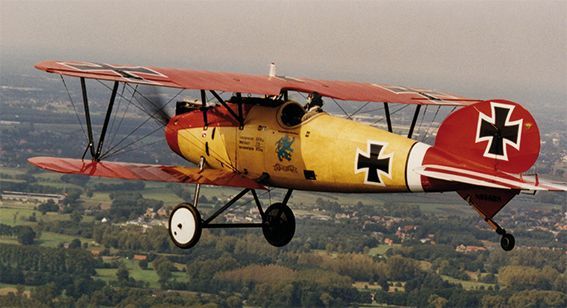
Albatros D.Va
Compared to the Spartan look of most World War I aircraft types, the Albatros, with its curvy and flowing lines, is one of the most bold and daring designs.
The Albatros D.V was the end result of the successful D.I series and entered service with the Luftstreitkräfte in 1917.
It was the last Albatros to see active service during World War I, despite its known shortcomings.
900 copies of the D.V and about 1,612 aircraft of the D.Va were built.
The Albatros D.V uses the same Mercedes engine as its predecessor the D.III. The main difference in this design by Thielen and his collaborators was the fully elliptical fuselage, which was 32kg lighter than the previous flat sided types.
The tailplane of the production machines was larger than the prototype and these aircraft also had a larger spinner.
The wings of the D.V did not differ from those of the D.III, but the upper wing was mounted slightly lower. The lower wing spar was no longer mounted in the fuselage, but attached to small bulges in the lower half of the fuselage.
The main difference was in the mounting of the control cables of the wing flaps.
The cockpit was fitted with a raised headrest, but this was usually removed as it restricted visibility and manoeuvrability too much.
In the D.Va version, the fuselage was reinforced, resulting in an additional weight of 40 kg. She was equipped with a Mercedes D.III of 180 hp.
The Albatros D.V entered operational service in May 1917. Structural problems were soon encountered with the lower wings, as with the D.III version. Moreover, there was little improvement in flight characteristics. Manfred von Richthofen, the Red Baron, was highly critical of the new type, describing the D.V as "so obsolete and ridiculously inferior to the English planes that you can't do anything with this plane".
On February 5, 1918, Lieutenant Von Hippel of Jasta 5 lost his entire lower wing during a dogfight. He managed to control his aircraft, but flipped over during the landing. Von Hippel escaped with a fright.
Tests conducted by the English on captured aircraft showed it to be very slow to maneuver, very heavy to fly and tiring to fly.
In response, the Albatros Flugzeugwerke came up with the D.Va version, which had stronger wing spars, sturdier wing ribs and a reinforced fuselage. It therefore weighed 23 kg heavier than the D.III, without any significant improvement in flight capabilities. A heavier Mercedes engine was also used and the control cables of the wing flaps were mounted back as on the older D.III.
The Albatros D.Va entered active service in October. Structural problems with the Fokker Dr.I and the mediocre performance of the Pfalz D.III meant that the German Air Force had no alternative to the D.Va, until the Fokker D.VII appeared on the battlefield in 1918.
Several well-known German pilots such as Manfred von Richthofen, Hermann Göring, Bruno Lörzer and Edouard von Schleich used this fighter.
Although the Albatros D.V was no match for the better British and French aircraft, but the Germans tried to achieve supremacy in the air by deploying large numbers.
At its peak in May 1918, 1.117 aircraft of this type were active on the Western Front.
The museum's aircraft is a replica built in the United States by Carl Swanson, using the original plans. It is equipped with a Ranger engine.
Stampe en Vertongen Museum vzw
Antwerp International Airport
Bus 3
B-2100 Antwerp-Deurne
Belgium
O.N. BE0447.236.613
RPR Antwerp
email: stampe@skynet.be
www.stampe.be
Opening hours individual visits
- Mon - Fri
- Closed
- Sat - Sun
- -
Closed on Easter Sunday and during August, December and January
Useful links
All rights reserved | Stampe en Vertongen Museum vzw






